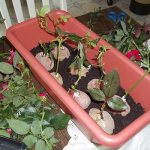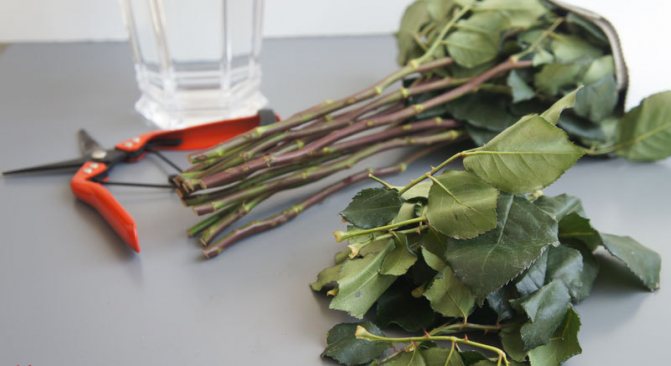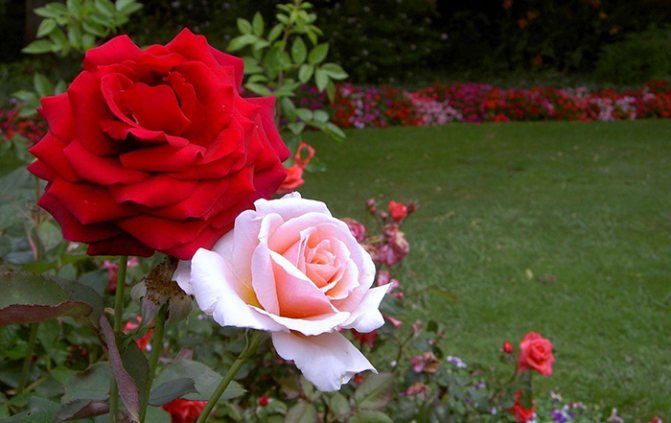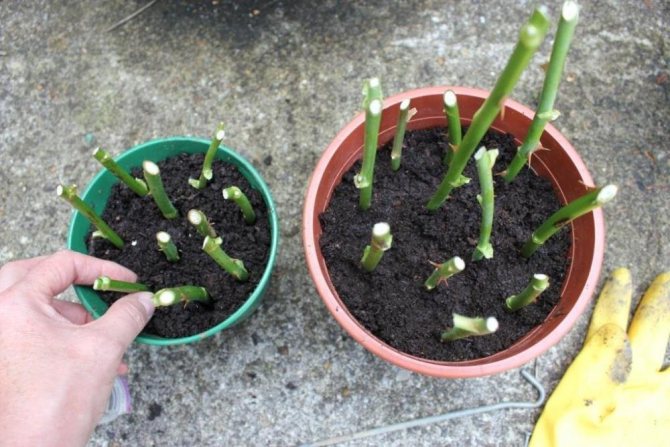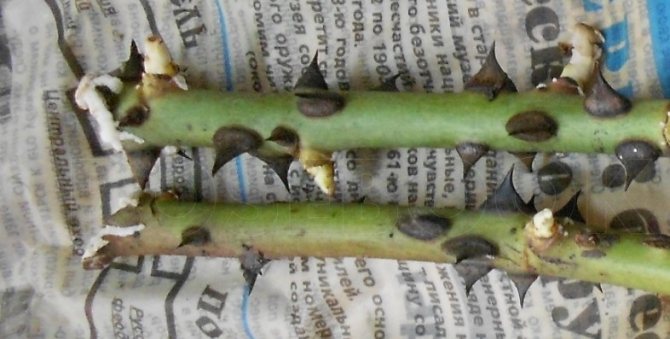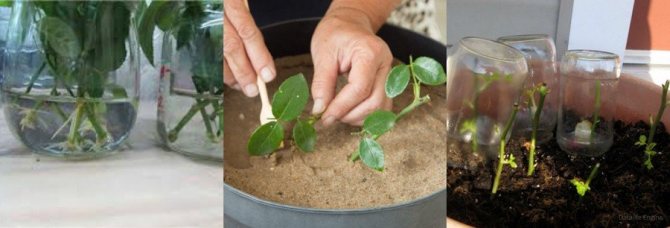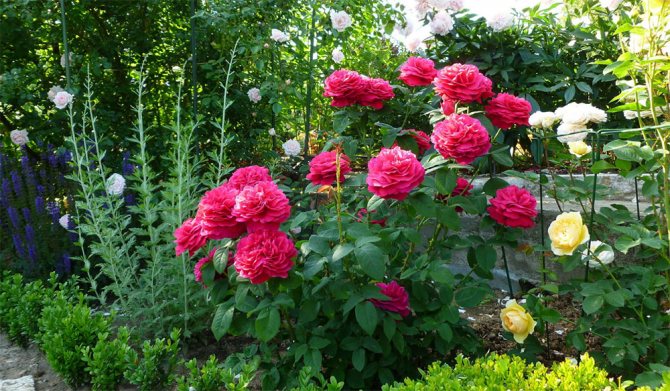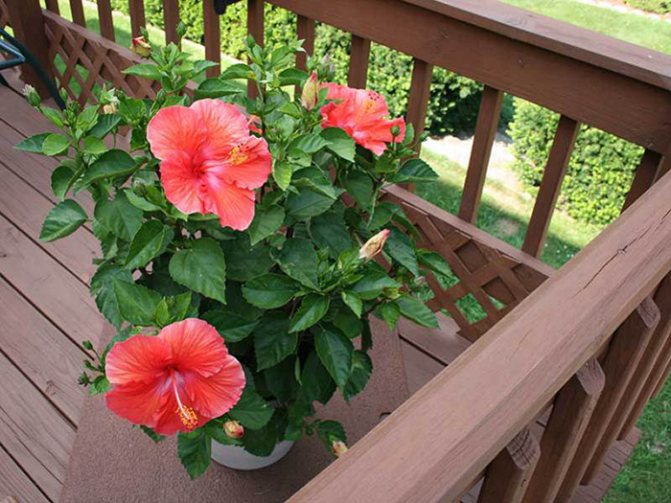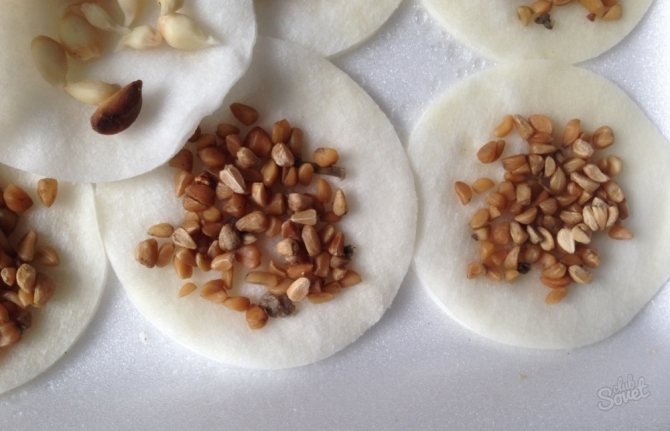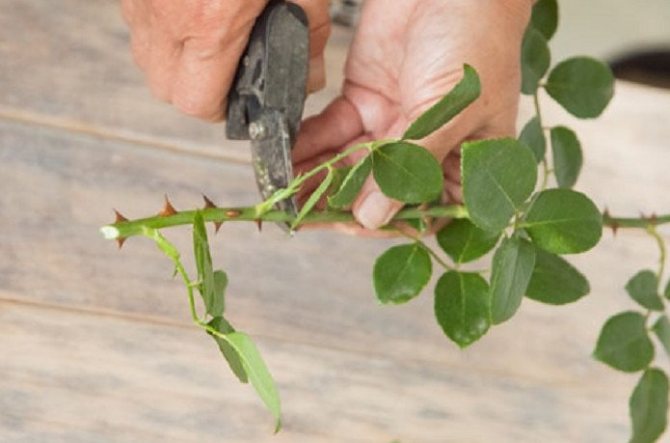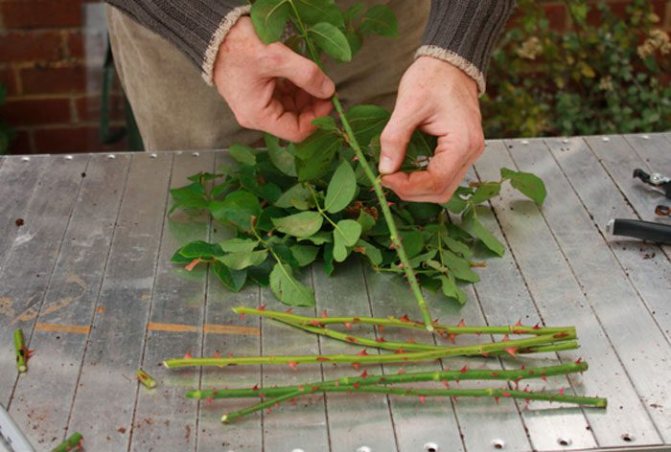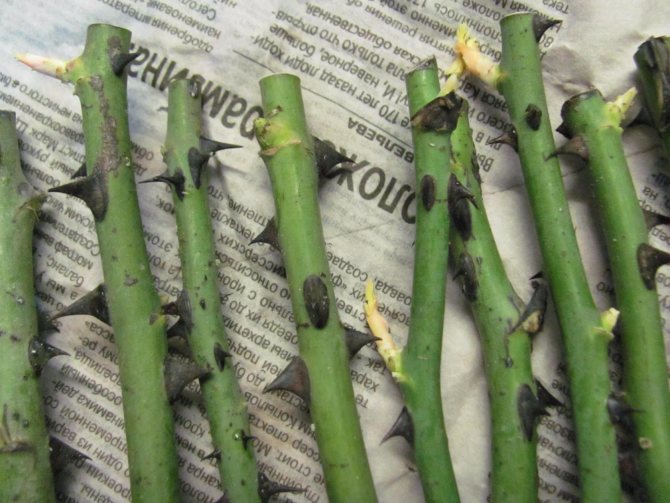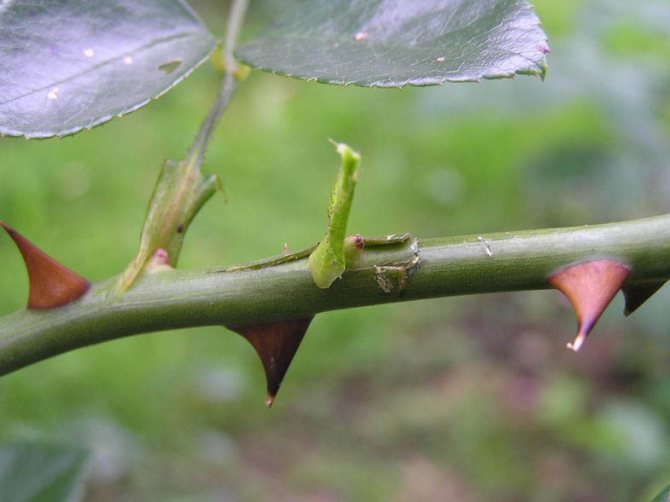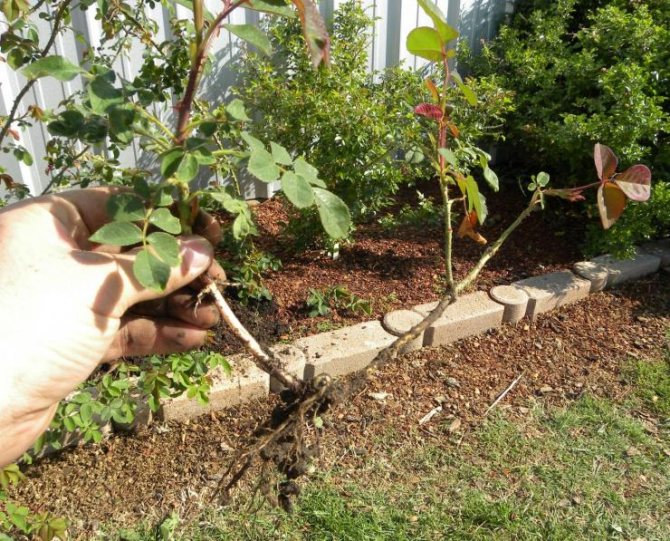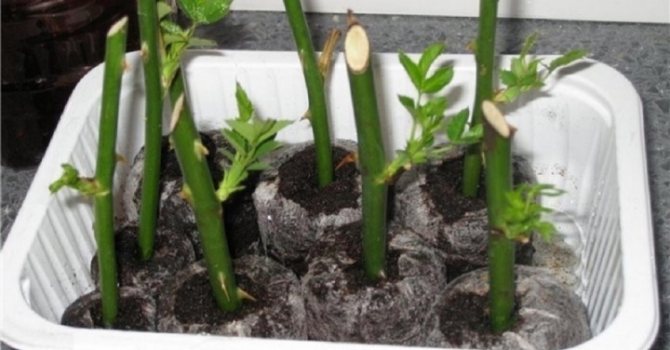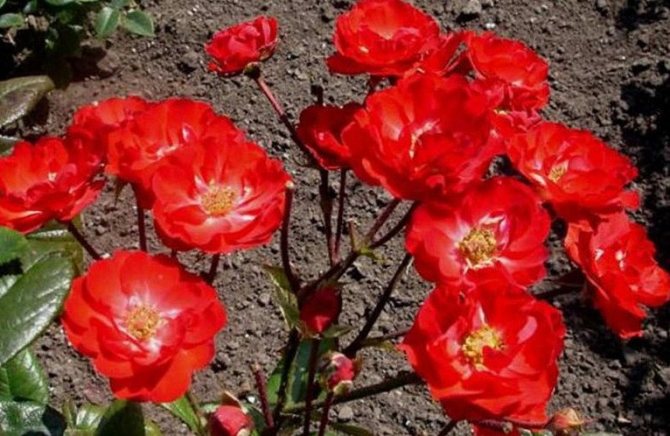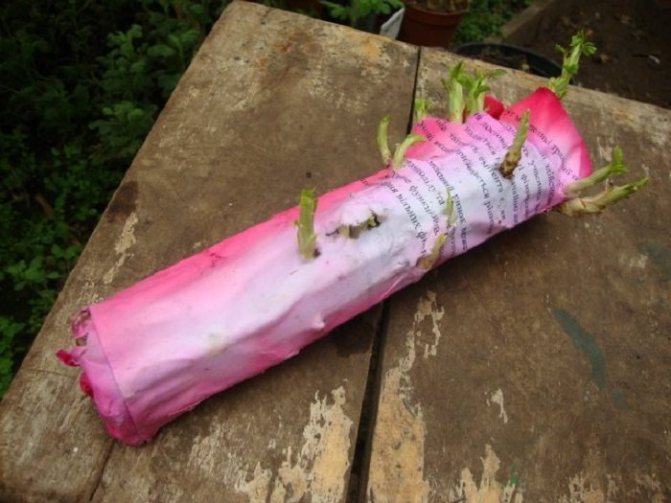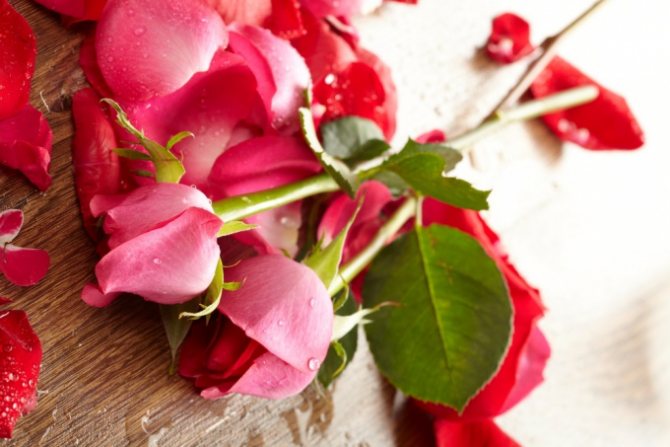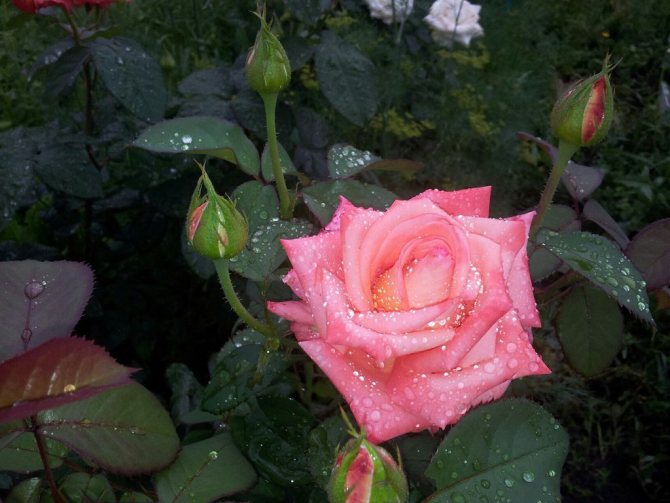Seeing a beautiful rose bush with gorgeous flowers in the garden of a neighbor or relative, many have a desire to break off the process and root it in their garden. Similar thoughts about transplanting into nutrient soil appear even in winter, when a bouquet standing in a vase suddenly takes root and new leaves.
Is such rooting possible, and how to grow a rose from a cutting at home? Consider in the article methods with water, a pot, potato tubers and a plastic bag.
Breeding methods for roses
Reproduction of roses can be carried out in two main ways: seed and vegetative. At the same time, some experts propose, as a separate way, to consider the vaccination technique, which still more often refers to vegetative reproduction.
The use of the seed method of propagation of roses is significantly limited, since most varieties do not always transfer their aesthetic properties to seedlings, however, this method is the main one in the practice of breeding new species to obtain a strong rootstock. The exception is park roses, which reproduce well by seed.
Vegetative propagation is represented by several methods, the most common of which are the following options:
- cuttings;
- dividing the bush;
- rooting by layering;
- reproduction by root suckers;
- graft.
Let us consider in more detail each of the methods presented above and reveal the secrets of the propagation of roses, which will come in handy for gardeners who dream of their own rose garden.
Tea rose
This variety is better known as a garden plant. Miniature varieties are grown at home. This species was obtained from the Bengal rose. Flower bushes can be both low - up to 50 cm, and high - up to 2 m. There are low-growing varieties that grow only up to 30 cm. Many are interested in how to propagate this type of rose? Very simple. As is the case with other varieties, it is better to plant a tea rose with cuttings, which are taken after the bush has faded.

It is very important to remember that it is better to remove the first buds afterwards. Then the flower will bloom magnificently again. The plant is very susceptible to cold and dampness. Therefore, you need to water it moderately and try not to leave it by an open window.
Here are just the main types of home and garden plants. In fact, there are a huge number of them, and you will need more than one volume to describe and take care of them. But the principle of reproduction is the same for everyone. It is better to use cuttings breeding. It is less labor intensive and more efficient.
The subtleties of seed propagation of roses
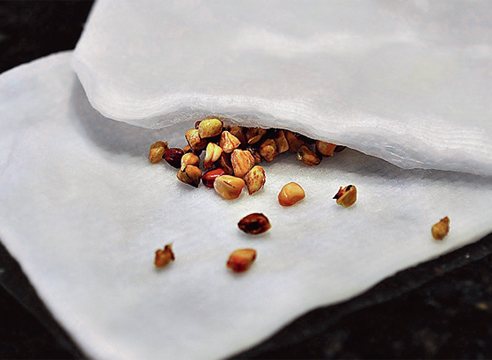

Rose seeds
In order to grow roses from seeds, the latter can be purchased at the store or collected in your garden. If you decide to prepare the seeds yourself, it is best to pick the fruits of the rose at the end of August, when they are not yet fully ripe and are just beginning to turn red. The fact is that seeds obtained from immature bolls are distinguished by better germination and form more viable plants. You should not collect seeds from fruits prone to rotting, since the resulting material is not suitable for planting.
When removing the seeds from the fruit, it is necessary to carefully and thoroughly clean them from the pulp, after which the resulting grains are treated with a solution of hydrogen peroxide for 20 minutes. It is best to perform this manipulation with a sieve. This procedure is aimed at protecting the seed from microbial spoilage and the appearance of mold. Most often, rose seeds have a different shape and size characteristics, but this should not confuse the gardener, since these parameters cannot significantly affect the level of germination of the seed.
Having received the seeds, you can grow roses from them both indoors (in a container) and directly in the garden. Depending on the conditions created, the seed germination technology will be slightly different.
Breeding roses from a bouquet
In order for the process of growing a rose to be successful, it is necessary to choose the right material and timing. For example, for the Moscow region, it is better to take bouquets donated in the spring-summer period.
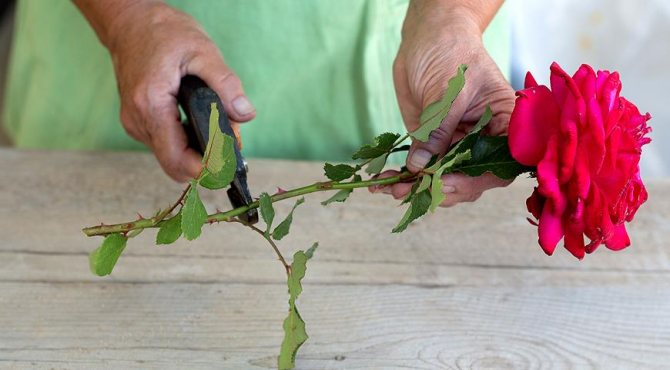

Reproduction of roses from a bouquet is one of the ways to plant your favorite varieties in your garden
The procedure can be performed at any other time, but the quality of the planting material will be questionable. The reason for this is:
- short daylight hours, insufficient for the development of the cutting;
- indoor air humidity during the heating season is not comfortable for stem germination.
Important! Indicators of air humidity for germination of cuttings should be 90 - 100%.
What rose stems are suitable for grafting
There are several rules according to which the stems are selected so that the rooting process is favorable. Knowing them, you can immediately select the appropriate copies:
- The stem should not have dried-on areas. There is no need to wait for the petals to fall from the flower. The best option is to select material for cuttings on the same day or the next morning.
- Determine the level of bud development on the stem. The presence of at least 2 - 3 at the base of the leaves is required.
- The thickness of the stems should correspond to the diametrical section of the pencil, not less.
- 2 - 3 leaves are left on the process, the rest are cut off.


Selecting stems for harvesting cuttings
Why does not a rose take root from a bouquet
Not every copy of the bouquet is suitable for grafting. For example, those varieties that have thick and fleshy stems of a reddish hue do not take root. They rot pretty quickly.
The result of germination and the degree of development of the root system depends on the variety:
- The process goes very badly with hybrids of tea varieties and parks.
- Floribunda, ground cover, bush and climbing roses germinate well.
- Foreign specimens grown in greenhouses for cutting are quite capricious under normal conditions. They do not lend themselves well to rooting.
- Domestic greenhouse flowers have a high germination rate.
Germinating rose seeds at home
The whole process of growing a rose indoors can be roughly divided into several successive stages:
Preparation for the statistic. A cotton pad or a small piece of cloth is abundantly moistened with a hydrogen peroxide solution. Rose seeds are spread on the resulting damp cloth and covered with the same cotton pad. Statification. The seeds, wrapped in a damp cloth, are placed in a plastic container or plastic bag and placed in the refrigerator. It is better to place the resulting container in an area where the temperature is about +5 ̊С. In this state, the seeds should spend about two months. In this case, you should regularly check and maintain the moisture level of the fabric. Germination. The certified seeds are transferred to a pot with soil or peat and conditions for germination are created: t - 18-20 ̊С, active lighting time about 10 hours, regular moderate watering. It is better to mulch the soil with perlite. Hardening.Before transferring the rose to natural soil, it should be prepared for environmental conditions by taking the pot outside daily, gradually increasing the residence time. Disembarkation. The best time to plant roses obtained in a similar way in natural soil is May. Roses are planted in pre-prepared holes, choosing a warm, well-lit place.
Growing roses in a bag
Breeding roses with cuttings at home is also possible in a package. Moreover, there are several varieties of this method with moss, newspapers or pinching the stem.
- In a bag with moss. Fresh and moist moss is placed in a tight plastic bag, spread out along the bottom of the bag. Then prepared cuttings of roses are inserted inside. The bag is inflated with the mouth, tied in a knot and suspended. Watering with this rooting option is not required due to the condensation accumulating inside, moistening the moss and the workpieces. By the end of the month, the roots grow, and the cuttings can be planted in the soil.
- In the bag and newspapers (Burrito rooting method). For propagation in this way, the cuttings are first soaked for a day in water at room temperature. Then several pieces are wrapped in ordinary newspaper, slightly wetting the paper. The wrapped bundle will interfere with the bag, left at home at a temperature slightly above 20 degrees. Weekly, the bag is opened, the blanks are inspected and the newspapers are slightly moistened. If any stem turns black or rotted, it is thrown away, replacing the paper around the remaining copies. Roots usually appear in 2-3 weeks.
- Trannoy grafting method. This method is rarely used by gardeners, has not received a public vocation. At the beginning or middle of summer, the cut stems are pinched, left until the process of swelling of the buds begins in the lower part. In this process, it is important to prevent the appearance of leaves from the buds, otherwise reproduction will be ineffective.
Germinating seeds in vivo
The procedure for germinating seeds in natural soil is much easier, however, the survival rate in this case will be much lower. In order to germinate the seed in the garden, it is enough at the end of August, immediately after collecting and processing the seeds, to plant them in the ground, lightly sprinkling them with earth. Further, the soil is slightly moistened and covered with a covering material, which protects the ground from freezing in winter. In the spring, the planting site is cleared and seeds are waiting for germination. You should be prepared for the fact that roses, which were obtained by seed reproduction, usually give a rather weak and short flowering in the first year, but by the next summer the bush forms full-fledged buds.
Caring for roses after planting
After planting, the roses must be watered, and the ground is sprinkled with large sawdust to retain moisture. At first, the bushes protect from direct sunlight. The adaptation of potted seedlings outdoors takes about two weeks, then they begin to grow.
Fertilization is required only for seedlings that have grown in height by more than 12 cm. For feeding, complex liquid solutions or infusions of mullein, herbs are used. In order for the garden plant to be strong, in the first year after planting, the buds are cut, allowing the bush to direct all its forces to the formation of stems. In the autumn-winter period, young bushes must be covered, protecting them from severe frosts.
Subject to the above conditions, in 2-3 years from cuttings, you can plant a gorgeous flower bed in the garden, without spending money on buying seedlings in the store.
Vegetative propagation of roses


Vegetative propagation of roses
The ability to reproduce vegetatively is a unique property of plant organisms, which manifests itself in classical regeneration. This process consists in the fact that the plant is able to completely restore its body from a separate part through active cell division.The main advantage of vegetative propagation is the complete predictability of the results, because the resulting plant will have all the characteristic features of the mother's organism.
If the rose was obtained by vegetative propagation, they speak of a rooted plant that, after the death of the aerial part, can form a new young shoot.
Chinese rose
The flower of this plant is very reminiscent of small gramophones of pink, burgundy or red. These are traditional colors, but in recent years, thanks to breeders, orange, yellow and even multi-colored buds have appeared. This is a durable plant that can delight its owners with flowering for 20 years. How to propagate this type of rose is discussed in the article below. And now a few words about the conditions of detention. This flower needs space, the ideal option is rooms with high ceilings, since its height can exceed 2 meters.
It is noteworthy that the plant has nothing to do with Rosaceae, nevertheless it is called a rose. Florists love this species because of its unpretentiousness. Although the flower grows to a gigantic size, it does not require frequent replanting. You just need to water it on time and fertilize it periodically. To give the crown a beautiful shape, you need to prune the branches.
Propagation of roses by offspring
The method of propagation of a rose by separating root suckers from the mother plant is most suitable for park varieties, since they give a lot of so-called "babies". The technique involves the transplantation of small free shoots, which usually form near the mother's rose, most often forming on the southern side of the plant. The method of separating offspring is quite simple, but does not always demonstrate a high level of efficiency.
You can get a rose by propagation by offspring by carefully separating young straight shoots from the mother's root system. It should be understood that newly formed offspring are not ready for independent survival, due to the absence or imperfection of their own root system. Before making a separation, the plant should be allowed to acquire roots and gain strength. This requires exposure, because the formation of a full-fledged root system takes about a year. Transplanting is best done in spring, when the soil has already warmed up enough, and the risk of cold weather returning is minimal.
Advice. In order to stimulate the formation of additional roots and get a beautiful bushy plant, when transplanting, prune the young stem, removing a third of the length of the shoot.
Professional advice
To successfully propagate curly roses, it is recommended to heed the advice of professionals in this matter:
- when harvesting cuttings, the lower cut is made under the kidney, the upper cut is above the last node at a distance of 1 cm;
- branches intended for reproduction are cleaned of leaves, flowers and thorns;
- in the spring, one should not rush to transplant the cuttings to the garden bed, it may turn out that they have not yet rooted;
- transplant the plant on a cloudy and rainy day.
Reproduction of roses by layering
Reproduction of roses by layering is excellent for shrub, climbing and ground cover plant varieties. The fact is that the propagation of a rose by layering is the priority and most effective way to get a plant that has all the qualities of a mother rose, but it is suitable only for those species that have strong and sufficiently long shoots. It is best to start the process of reproduction of a rose in a similar way in early spring, following the following steps in sequence:
We carefully dig up the ground near the rose bush, without damaging the root system of the plant and removing all existing weeds. The loosened earth is mixed with some peat and sand.We select the shoot of the mother rose, which has the most superficial location, and remove all the leaves. In the area of one of the lower kidneys, we make a neat annular incision and insert a match or a chip into it. In loose and well-moistened soil near the bush, make a small depression (about 10 cm). The selected and pre-cut shoot is bent so that the upper part of the trunk is in the prepared hole, and sprinkled with earth. The soil must be well tamped so that it holds the buried shoot. If the trunk has too dense and elastic base, it can be secured with special bows made of wire or tied to a metal peg. The cuttings are watered regularly. In summer, especially in hot weather, watering must be done daily, which will contribute to the early formation of the root.
Thus, by the beginning of autumn, the cuttings form their own root system. At this time, the rooted shoot can be shared with the mother rose and transplanted to a new location. Some gardeners, in order to increase the probability of survival of the cutter, recommend replanting only the next spring.
Another option for reproduction of the Queen of Flowers by layering is to obtain vertical shoots, which is more often used for the industrial production of seedlings. In this case, the rose is subjected to a short pruning, leaving only 5 cm above the ground, after which it is spud so that the entire short sprout is covered with loose soil. Hilling continues as the plant grows, using loose, well-moistened soil for this purpose. In the fall, gradually removing the soil, the rooted individual layers can be shared with the parent plant and transplanted to a new location.
Reproduction of a home rose
Indoor rose is a decoration for any home. With good care, it pleases with its flowering all year round. But the rose bushes grow old and fade away. In order not to be left without a favorite flower in the house, it is necessary to learn how to plant it.
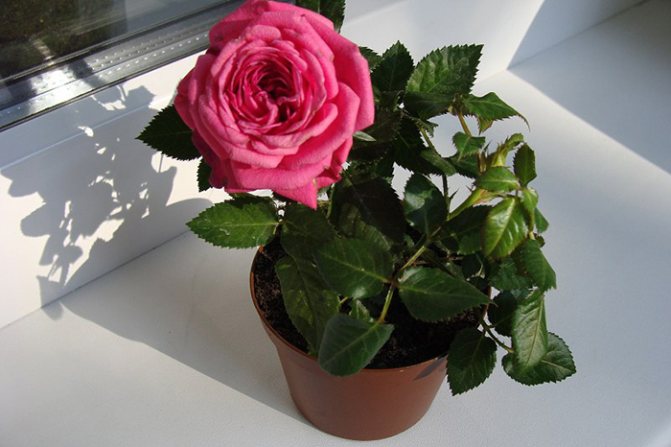

Indoor rose
A home rose multiplies by germination, and how best to do this there is useful information that, if desired, can be used by every housewife without any effort.
A young, strong twig with buds is separated from an adult rose bush. It sinks into a vessel with water, which should be changed sometimes and some growth stimulants added to it for faster germination. It remains only to wait for the appearance of the roots.
After the roots germinate, the plants are planted in pots with a special soil for roses and covered with a transparent glass vessel for rooting. Occasionally, a future rose is watered with settled water. If everything is done correctly, a fresh young bush will soon bloom.
Propagation of roses by cuttings
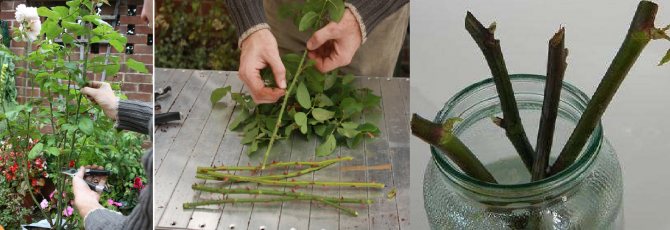

Cutting propagation of roses
Reproduction of roses by cuttings is one of the simplest, most affordable and effective ways to get a healthy bush. This technique is so unpretentious that it allows you to reproduce even flowers collected in a bouquet. This method is actively used in relation to miniature and polyanthus varieties, as well as for Floribunda roses.
Correct cuttings require a viable plant to be obtained in the shortest possible time. To obtain cuttings, you should take a healthy and sufficiently strong annual shoot, which should have a thickness of about 5-6 cm. The cut is the middle section of the rose shoot, obtained by two pruning. The upper pruning is done just above the kidney (2-3 cm), while the lower one can be done just below the kidney. Cuts should be made with a very sharp instrument, preferably a razor blade, and should be angled.
Preparing cuttings for planting involves removing all the lower leaves. At the top, it is allowed to leave two leaf plates, however, the surface of the trimmed shoot will have to be freed from all thorns.Before planting, the lower cut must be treated with a special growth stimulant.
Landing can be done in several ways:
- Classic planting in loose soil at an angle of 45̊.
- Rooting cuttings in a greenhouse.
- Planting cuttings under banks, etc.
You will find a detailed step-by-step description with a photo of how to grow roses from cuttings on our website.
Regardless of the chosen method of rooting the cuttings, you should use fertile, well-moistened soil, which will increase the effectiveness of this propagation technique. Interestingly, the grafting method is better suited for varieties with dark flowers - burgundy, deep pink, red, etc. The percentage of rooted cuttings for plants with light flowers is significantly lower.
Rooting methods for cuttings
How to propagate spirea and root from a twig
Before planting roses at home, you need to choose a suitable rooting method. There are several methods:
- germination in water;
- bedding;
- the use of young potatoes;
- rooting with a newspaper and so on.
Rooting in water
Placing a prepared cutting in a glass of water is the easiest way to germinate. For this, spring or rain water is used, in extreme cases, filtered. If you take a regular tap water, then the chlorine in it will not allow the roots to develop.
A container with water and cuttings is placed in a place where direct sunlight does not fall. It is better to use glassware for this purpose. It is so convenient to observe the development of the roots. The water level in the glass should be such that the stems are immersed only a couple of centimeters to avoid tissue decay.
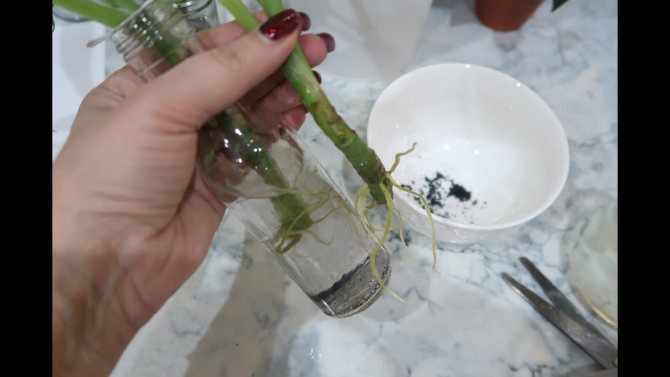

Sprouting roses in water
Water should be systematically replaced, on average, once every 2 days. Roots will appear in 2 to 3 weeks. But there is no need to rush into the ground. You need to wait a few more days for the root system to develop better.
Important! This method of germination has a slight drawback. The oxygen content in water is quite low. Cuttings may not germinate or develop slowly and rot.
Rooting in the ground
You can germinate a stalk in a pot of soil. The stalk is placed in the soil at an angle to a depth of at least 2 - 3 cm. It is possible at the level of the second bud. Then poured abundantly with water at room temperature. To avoid crust formation, cover the soil surface with dry soil. Finally, create a greenhouse for the sprout by covering it with a glass jar or cut plastic bottle.
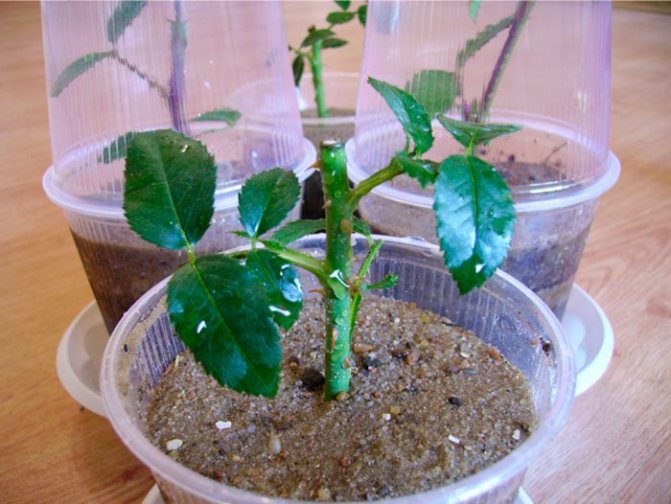

Rooting cuttings in a pot of soil
The pot is placed in a warm place with proper lighting. The best option is a window sill on the east side of the house. The air temperature in the room should be +22 - 25C.
Important! If the pot is large enough and there is a desire to plant several cuttings in it, then it is necessary to place them at a distance of 15 cm from each other.
Rooting with potatoes
There is also an unusual way of rooting cuttings of a rose from a bouquet - with the help of young potatoes. On prepared stems about 20 cm long, leaves and thorns are removed. A trench 15 cm deep is prepared at the site. Sand is poured at the bottom in a layer of 5 cm. The cuttings are stuck into the potatoes and in this form are placed in a trench at a distance of 15 cm. Sprinkle with soil and cover with jars.
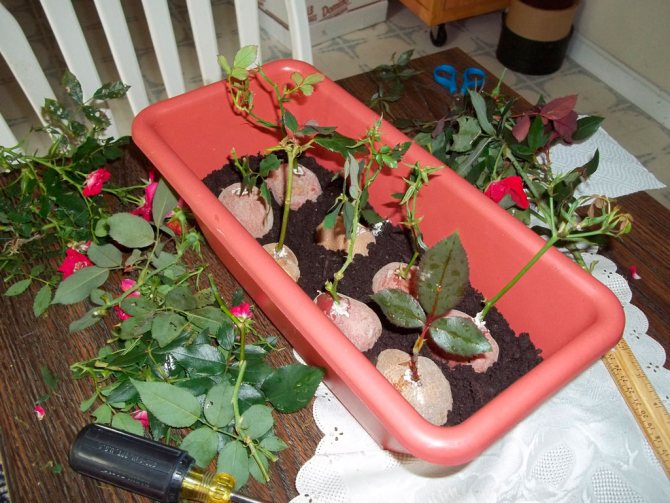

Rules for germinating roses from a bouquet using potatoes
Potatoes nourish the cuttings of roses with all the necessary substances, at first they supply them with moisture. In this case, there is no need to fertilize. It remains only to systematically water. Every 5 days, the soil is moistened with a solution of water and sugar. In 1 glass of liquid, 2 teaspoons of granulated sugar are diluted.
After 2 weeks, the cuttings begin to open for a while, and after a couple of weeks the cans are removed altogether.
Use of growth stimulants
For better development of the root system of cuttings of roses, growth stimulants are used. It is better to use folk recipes with natural ingredients for this:
- Dissolve 100 g of yeast in 1 liter of water. Cuttings are placed in it for a day, deepening them somewhere in 1/3 of the length. Then the stems are washed and water is added until the roots appear.
- 1 tsp honey is dissolved in 1 liter of water. Prepared rose stems are placed in the solution for 12 hours.
- Add 10 drops of aloe to a container of water in which the cuttings are located. After 10 days, add another 5 to 7 drops.
Important! When the cuttings are placed in water, the liquid level should be up to half the stem. When the liquid evaporates, water is constantly added.
Care of cuttings during germination
When planting cuttings in the ground, you need to look after them. Care consists in systematic watering and airing. After about a month, small leaves will begin to appear. From this point on, they begin to remove the cans for a while for fresh air access to the sprouts and hardening. Banks are completely removed after 10 - 15 days.
Throughout the entire rooting process, care must be taken to ensure that the plant does not suffer from a lack of moisture. The soil is watered around the greenhouse, and during the airing, the cutting itself is sprayed.
Landing in the ground
The rose has taken root, what to do next? There is no need to rush to plant it in open ground, especially for the winter. Having planted a still weak sprout in the ground in the fall, you can destroy it. He will not be able to survive such strong shocks. It is better to postpone this process and plant a seedling in the spring.
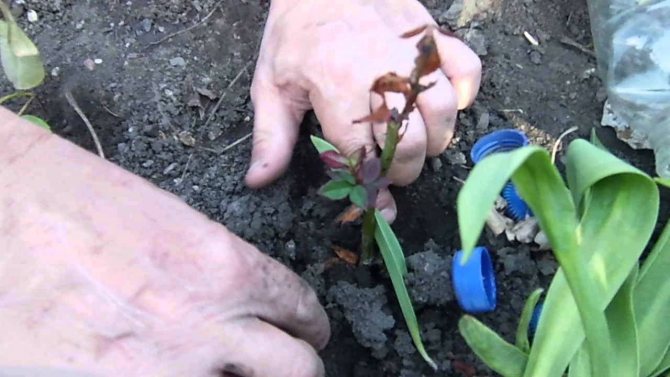

Rooted cuttings of roses are planted in the ground in spring
Place pots with planting material in a cool place where the temperature will not drop below +3 - 5 ° C. At this temperature, the seedling will be able to harden and it will be easier for it to take root when planted in open ground.
Important! Rose seedlings are planted in the ground in April or May.
Reproduction by dividing the bush
This method is only suitable for adult, healthy bushes with many full-fledged shoots. In order to divide one bush into several separate plants, it must be completely dug out without damaging the root system of the rose. This is best done in early spring, since after planting individual parts of the plant, they need some time to recover in favorable conditions, which corresponds to warm, sunny weather. The dug out bush is pruned, removing two-thirds of the shoots and one-third of the roots. Next, the plant is divided with a pruner, pre-treated with a solution of any antiseptic, into several separate parts, each of which should have a full-fledged part of the root system and one healthy shoot, with at least two buds.
The roses obtained in this way are planted in a superficial way, deepening the root system by 5 cm into a well-loosened and fertilized soil. Watering such a young plant should be regular, so that part of the plant is well rooted and regenerated. A full-fledged bush with abundant long flowering can thus be obtained in 1-2 years after dividing the mother plant.
Planting cuttings to a permanent place
Planting young shoots in open ground is done in spring or autumn. In spring, the soil temperature should be above 10-12 degrees Celsius, and the air temperature - at least 15 degrees. Autumn work should be completed by mid-October, starting from the 15th of September. This is necessary so that the sprouted cuttings have time to take root before the onset of cold weather, but they cannot start new shoots.
Here are some rules for planting cuttings with roots in open ground.
- The hole is dug 5-6 cm wider and deeper than the size of the pot in which the rooting was carried out.
- A shovel of peat or humus is poured onto the bottom of the hole, sprinkled with earth on top.
- Cuttings together with an earthen lump are placed in a pit.If the roots are formed in water or newspaper, the workpieces are first soaked in the rooting machine, only then they are carefully set in the pits in an upright position.
- Roses are covered with nutritious soil on the sides and on top, tamped.
- Water the plantings, cover for several days with cut plastic bottles for better survival.
- In autumn, the soil is mulched with needles, dry grass, peat, the stems are covered with spruce branches or a special covering material.
When planting in spring, the seedlings are also protected from possible frost, covered with film or bottles on top. The protection is removed only when real green leaves appear. Plantings are sprayed daily from a spray bottle, trying not to overmoisten the soil too much.


Propagation of a rose by grafting
Grafting is a technique that is based on artificial splicing of a cuttings of one rose, which is called a scion, with the base of another plant, in this case, a rootstock. Simply put, this method of reproduction involves the growth of a healthy cuttings of a rose of any variety to the stock of a frost-resistant and drought-resistant rose hip. The result is a plant that simultaneously possesses excellent aesthetic properties and has a low level of sensitivity to aggressive external environmental factors. Cinnamon rose, wrinkled rose or dog rose can be used as a rootstock.


Propagation of roses by grafts
It is best to inoculate plants in winter or summer, since these seasons are characterized by the most active sap flow processes. Depending on the season chosen, there are two types of vaccinations:
What is the advantage of cuttings?
To root a rose with a cuttings, you do not need to be an experienced specialist - the procedure is available even to a beginner in the gardening business if the source material is available. You just need to know that park yellow and wrinkled varieties do not reproduce in this way, but climbing and miniature varieties take root without problems.
Although grafting is a longer process than planting store-bought seedlings, it has several important advantages.
- Cost savings and low cost of the method. The price of one purchased bush in a gardening center or an online store is about 200-400 rubles, or even more, depending on the variety. Having bought only 2-3 bushes, you can breed a whole rose garden in a couple of years by cutting the shoots. Or you can even ask for a twig from a neighbor or friend, without spending a single ruble on the future bush.
- Preserving the memory of the bouquet. Cutting gorgeous roses will stand in a vase for at least a couple of weeks, often only 3-4 days. But having rooted the cuttings, you can admire the beauty of the buds every year in your own garden or flower bed.
- Easy care after disembarkation. The bushes obtained by cuttings do not form root shoots after planting, they winter better from the second year than purchased varieties. Even when the aboveground part freezes out in a harsh winter, roses quickly recover from dormant buds on the roots.
- The possibility of rooting at different times of the year. The varieties you like with beautiful buds can be propagated from late June to late July, after flowering and leaf fall in late autumn. And also in the spring and winter, selecting copies from the bouquets presented on March 8 and New Year.
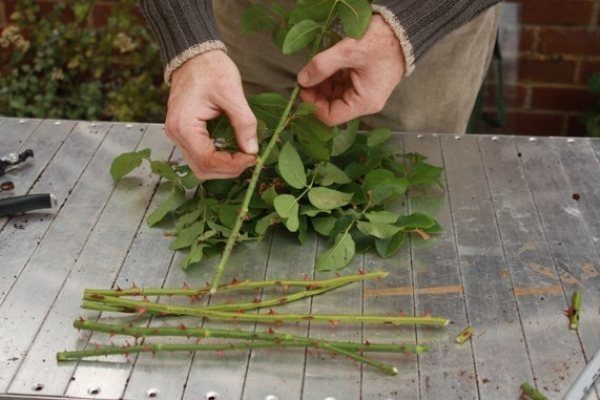

Summer vaccination
Summer grafting is also called budding and is considered one of the most effective and rational ways to reproduce a rose. This event is carried out from mid-July to mid-August. Budding consists of the following stages:
The rosehip used as a stock is dug up a little, carefully freeing the root collar from the ground. In this case, it is better to remove all side shoots. On the root collar, an incision is made in the bark in the form of a letter T, so that the length of the vertical line is about 4 cm, and the horizontal line is no more than 1.Prepare the cuttings by removing all the leaves and cutting off one eye. The peephole is cut with a blade from the bottom up. The cut peephole is placed in an incision on the root collar and rewound with a special budding film. The survival rate can be determined 2-3 weeks after vaccination, by observing the eye, which should have a fresh green color.
Before the winter cold, the vaccination site should be earthed so that it is completely covered with soil at a distance of about 5 cm. In the spring, the soil is removed along with the budding film.
How to prepare cuttings
A stalk of a rose is a small length of the stem from an adult plant without roots, with 2-3 living buds. Knowing how to grow a rose from a cutting at home, you can effortlessly turn the blank first into a full-fledged seedling, and over time - into an overgrown rose bush.
It's important to know. For grafting, the upper or middle part of the stem, cut from a healthy plant, is suitable. It is better to choose semi-woody shoots for reproduction, which are about to bloom or are already fading, dropping petals to the ground.
The procedure for harvesting cuttings is simple, it consists of several stages.
- In the garden, on a bush or from a bouquet, strong stems with beautiful buds are chosen. Shoots should be light brown, not green, as immature ones are not suitable for germination. Lignified stems of dark brown color are also discarded - they usually rot without taking root in water or a pot of soil.
- Blooming buds that have opened in a vase or that have faded on garden bushes are cut off - they are not needed for cultivation.
- The stems are cut into short pieces 15-25 cm long, leaving 3 buds on each. Above the top, a sprout is cut off by 1 cm, under the bottom, a margin of 1.5-2 cm is made. Moreover, the cut from the bottom is performed at an acute angle. Cut the blanks with a sharp secateurs or scissors.
- All the lower leaves and thorns are removed, the upper leaves are cut by a third to reduce the evaporation of moisture.
- The workpieces are placed in water for 5-6 hours, stirring any root growth stimulant according to the instructions.
After completing the above procedures, you can choose a suitable breeding method - in water, in a pot or in a flower bed using potatoes. Moreover, it is better to cut roses with blanks cut from the middle of the stem.
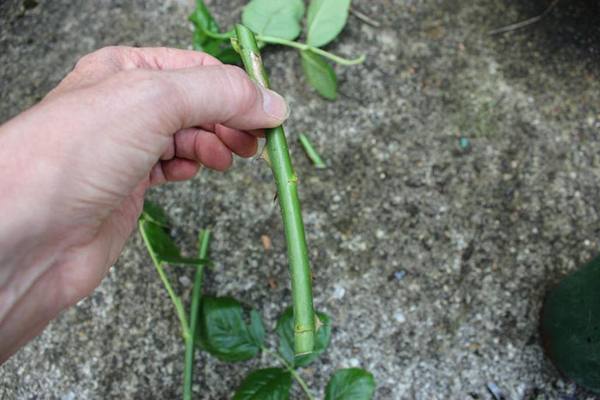

Winter grafting
Winter grafting is best done in February. The stock prepared in advance is stored in a warm room, in a mixture of sand and wet clay. A neat oblique cut is made on the scion handle, while a cut is also made on the rootstock trunk, but strictly lateral. The places of the cuts are treated with a garden broth, combined and tightly fixed with a special film. After a few days, the plant can be planted in the ground and kept warm until early spring, when the transfer of the rose to natural garden conditions is permissible.
We hope that the advice of our experts was useful for beginners and experienced gardeners and now you can easily independently acquire new specimens of luxurious and fragrant flowers.
Types of blooming climbing roses
This is the most beautiful climbing plant. But to grow such splendor, you have to work hard. First you need to know that climbing roses are of two types: multi-flowered and large-flowered. The first type has shoots up to 5 m long. Small flowers reach 2.5 cm in diameter. We will talk about how to propagate roses by cuttings just below.
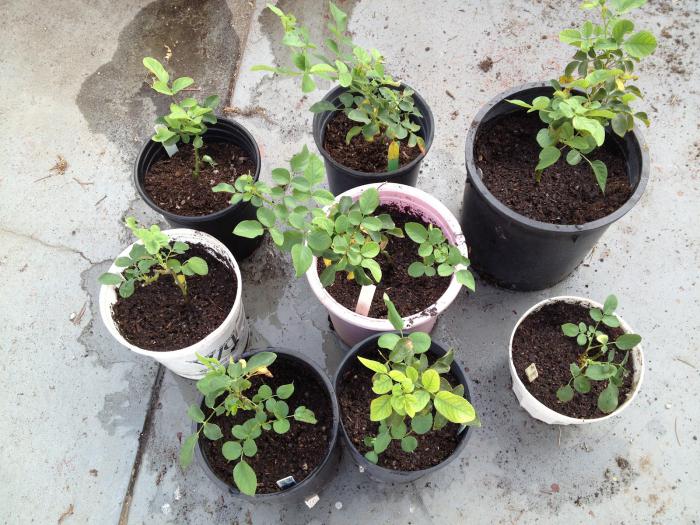

They are odorless, grow in large clusters of several dozen flowers. Multi-flowered roses bloom once a year for a month. Large-flowered reach a length of 3 meters. They bloom longer than the previous species, and often more than once per season. The inflorescences have a pleasant smell, in appearance they resemble a hybrid tea rose. One brush contains up to ten buds.
In the soil
And how to grow a rose in soil from a cuttings at home? This type of rooting is the most difficult in comparison with the others, but it gives a good result by increasing the percentage of plant survival.
How to grow a rose from a cutting? To begin with, pour a layer of drainage on the bottom of the pot. It is better to use medium-sized fragments of bricks or rubble as it. After that, the drainage is covered with a special soil for roses. It can be purchased ready-made from flower shops or garden shops. But the best option is to prepare the soil with your own hands. To do this, mix in a small pot in equal amounts sod and leafy soil with sand (1/3 sod land, 1/3 leafy soil and 1/3 river sand).
The prepared mixture is additionally covered with sand on top of 5-7 cm. When planting cuttings, it is worth checking that they are deeper than the layer of sand, that is, directly in the ground.
It is better to place the cuttings obliquely, with an oblique cut down, at a distance of about three to five centimeters from one to the other. The distance directly between the rows themselves should not be less than ten centimeters. After that, the flowers must be watered with clean water and covered with glass jars or plastic bottles with a cut-off bottom.
Roots will begin to form after 25-30 days. Throughout this period of time, the soil must be kept moist. When the first young leaves appear, in order to harden the plant, you can occasionally remove the cans (bottles), which can then be completely abandoned.
Carrying out cuttings in late spring or summer, some gardeners try to immediately plant roses in the garden, others still resort to using pots so that temperature drops and bad weather conditions cannot harm the plants. Moreover, in late autumn, in any case, it will be necessary to dig up the cuttings that have grown in the garden, and then transplant them into pots and remove them into the house so that the young bush will survive the winter.
Suitable breeding season
It is best to carry out cuttings of such a plant in the fall or at the end of spring. It should be noted that in June there is an intensive growth of shoots, and in late summer - early autumn, the vitality of the rose decreases. All this is bad for rooting.
Choosing a different time for the flower to reproduce can negatively affect the root formation process. The most unfortunate period for breeding is considered to be the winter months. The result of work at such a time can be negative. Before planting cuttings of roses at home, it is necessary to provide the cut specimens with the optimum temperature, light and humidity.
Selection of starting material for germination
To avoid disappointment and not waste time on obviously failed options, you need to make sure in advance that the roses you like are suitable for getting a high-quality cutting.
Tips for choosing suitable rose bushes for grafting:
- Do not cut off shoots from too young flexible or, conversely, very old woody plants.
- Refuse to reproduce recently introduced imported species.
- Give preference to domestic varieties or flowers that have undergone long-term acclimatization.
- Select only healthy and strong shrubs of medium size without external signs of wilting, damage and / or disease (specks, mold, etc.).


It is necessary to prepare the bush for propagation by cuttings in advance by making additional dressings under it
An important indicator of readiness for breeding is the presence of easily breaking off thorns - this indicates a sufficient maturity of the parent rose.
Care
How to propagate a climbing rose
Water the plants 1 time / 7 days. In hot summer they are irrigated more often. Sprinkle, use sprinkling.
In the spring of the next year, after planting, they begin to feed the roses. For the first time, twice calcium nitrate is introduced (1 tbsp. Lodge. / 10 l. Water).Take a break of 14 days.
During budding, Superphosphate (30 g / m2), Kemira universal (40 g / m2), liquid mullein, chicken droppings, wood ash are used. Organic substances alternate with mineral complexes.
Fertilizers are applied every 2 weeks. Do not feed during the flowering period. Fertilized for the last time in autumn (September). After the bushes have faded, Superphosphate, potassium salt is added. In the fall, fertilize with organic matter for the last time.
Weeds are weeded, the soil is loosened, the near-trunk zones are mulched with peat or humus. Bushes are formed in spring. In the summer, wilted inflorescences, withered leaves are removed. Sanitary pruning is done in the fall.


Superphosphate
In August, they begin to prepare roses for winter. Reduce watering. After September 20, the lower leaves on the bushes are cut off. They cover the plants when the temperature is -5 degrees. Shoots are cut off, the bases are covered with earth, peat, humus. Bend the tops to the ground. Cover with spruce branches, wrap the top with a non-woven material, then with a film.
Potato cuttings method
In recent years, a somewhat extravagant method of rooting cuttings has been gaining popularity. Not all growers recognize it, but if you have a progressive outlook on the world, you can also try the potato technique. It is equally suitable for rooting cuttings taken from a bouquet as well as those taken from a normal rose bush.
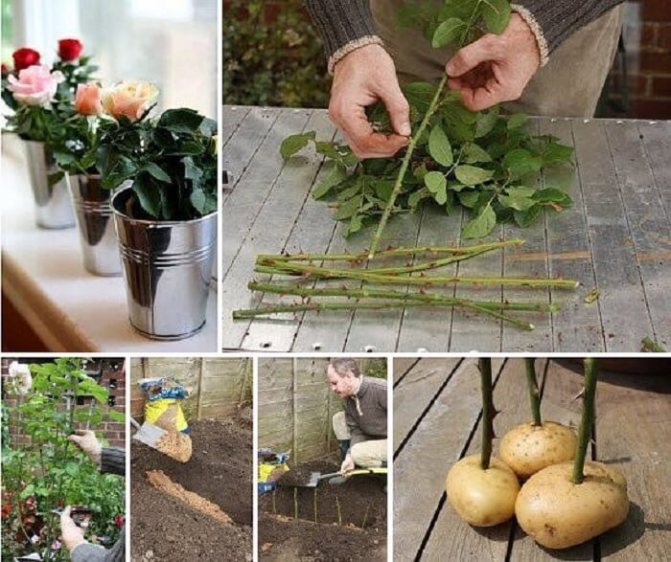

The preparation of the cuttings themselves is carried out in exactly the same way as if you were preparing to root them using traditional methods. The garden bed should be either an indoor greenhouse / greenhouse or a pot of soil placed indoors. Next, you need to take young medium-sized potato tubers, carefully remove all the eyes with a knife (try to damage the potatoes as little as possible) and stick one cutting into each tuber. We add the resulting structure to the garden bed (potatoes down, of course) or in a pot. In this case, the potatoes are laid on a layer of sand and covered with soil. Cuttings should be planted no closer than 10-15 cm apart. The aboveground part should traditionally be covered with a glass jar to create the most comfortable conditions for the shoots.
Immediately after planting, the cuttings should be watered with water with potassium permanganate dissolved in it to a light pink color. In the future, watering is carried out with water and sugar (one spoon per liter) every five days. When it becomes obvious that the cuttings have survived and have begun to sprout, the cans can be gradually removed to harden the young plants. In general, cuttings should be kept under glass protection for no longer than 15 days.
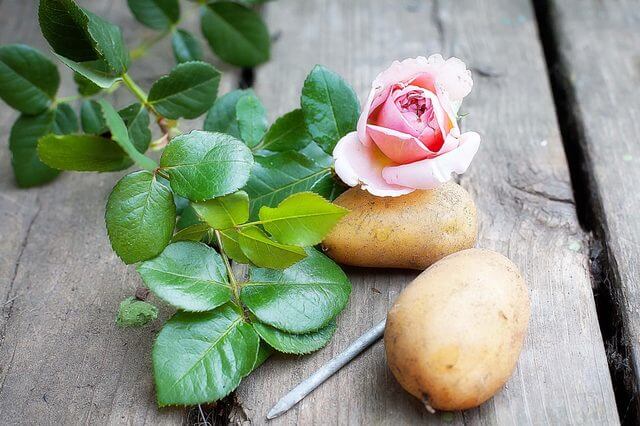

The main advantage of the potato method is the optimal combination of moisture and nutrients that pink cuttings provide potato tubers. As a result, rooting is faster, and the survival rate of plants is higher.
The technique is suitable for most varieties. So, if you do not know how to grow a climbing rose from a cutting, you can try this method.
Preparing a site for planting seedlings
To choose the most suitable planting site, you need to focus on the individual needs of the varieties:
- Photophilous ones are located in open elevated spaces.
- Shade-loving ones can be planted near fences, trees and other bulky shrubs. And they are also great for creating a hedge around the perimeter of the site.
Preparing the soil before planting rose cuttings is carried out in 2 stages:
- For 1-3 months, dig up the earth to a depth of about 55 cm. Add a mixture of sand, clay and compost (1: 1: 2) and loosen;
- Immediately before planting, partially replace the soil in the place of constant growth with a fresh mixture consisting of turf, humus and sand (2: 1: 1).
Advice. It is recommended to pay attention to the original soil type.Loamy requires minimal preparation, while clayey often has an increased acidity level (pH <5.5), which it is desirable to neutralize with a weak solution of slaked lime.
How to plant a royal flower
The advice of experienced florists will be useful to anyone who has decided to grow a royal look from a luxurious specimen presented for a celebration. First you need to prepare a flowerpot, a substrate, read the recommendations, evaluate your strength, think about whether there will be time for painstaking work. Untimely watering, non-observance of the humidity, temperature and lighting regime will easily destroy a young seedling.
Soil and capacity
To root the selected cuttings, you will need a nutritious yet lightweight substrate. A good option is to purchase a ready-made soil mixture for roses or violets at a flower shop, add ½ part of the sand for good drainage. Cut cuttings root well in a flowerpot, where sphagnum moss is added, which provides sufficient soil moisture and good aeration.
Another option for the substrate: mix humus (1 part) and turf soil (2 parts), add sifted river sand (about 2 cm) on top.
Soil disinfection is an important nuance that not all amateur flower growers know about. A simple technique prevents the multiplication of fungal flora and rot of various kinds.
Important points:
- a weak solution of potassium permanganate is a cheap means for disinfecting soil, but the effectiveness is lower than that of special preparations from an agricultural store. Other options for dealing with rot are described below;
- biological agent Glyocladin is effective and safe. For a flowerpot with a volume of 200 to 300 ml, you will need 1 tablet, which is buried 2 cm in the soil;
- the second option is to use the drug Fitosporin. After preparing the working solution, according to the instructions, the substrate is watered before and after planting the cut rose twig.
Rose cuttings, unlike many indoor flowers, are not placed in a container of water for rooting. With this approach, the cut site decays over time.
What container is needed to grow a rose from a bouquet? The material for the flowerpot is not so important (clay or plastic pot), it is important to pay attention to good drainage. The holes in the bottom must be large enough, otherwise stagnant water will lead to rotting of the bottom of the cuttings. The volume of the container is medium, so that the cut stem can receive enough nutrients from the substrate.
Processing and germination of cuttings
After preparing the soil, they begin to prepare the planting material. Growth stimulants are sold in flower shops. It is useful to keep the cutting in a solution of Zircon, Heteroauxin or Kornevin. The preparations are diluted according to the instructions. Another option is to place the cut part in a honey solution (take a teaspoon of bee product for 1 glass of lukewarm water).
Important! A stalk is cut from a long branch for planting only with a sharp knife; it is strictly forbidden to use scissors. In the presence of a special pruner, a professional florist's tool is used.
Rooting
Procedure:
- choose suitable cuttings with buds and several leaves;
- take a special pruner or a well-sharpened knife, make an oblique cut (45 degree angle). The operation is performed in the area near the lower kidney (immediately below it). With an oblique cut, the largest number of roots is formed;
- a sharp knife is used to process the top, the cut is made even, the surface is covered with garden varnish to prevent rotting;
- it is useful to cut the lower part crosswise, carry out treatment with growth stimulants (description of the process in the previous section);
- the leaves are slightly shortened to reduce the consumption of nutrients for the green mass;
- a stalk is planted in the prepared soil slightly at a slope. Deepening is carried out at the level of the second kidney (about 3 cm), but make sure that at least 1 kidney remains outside;
- after the specimen is watered with warm enough water, sprinkle with sand or dry soil (about 1 cm) to retain moisture;
- the next stage is the creation of a mini-greenhouse to maintain optimal humidity (from 90 to 100%). For this purpose, a plastic bottle with a cut-off bottom is suitable (leave 2/3 of the length of the container, always with a lid) or a liter jar. Some growers use a thick plastic bag;
- the mini-greenhouse is transferred to a bright place to root the stem of the rose.
How to save for the winter?
To maintain the viability of cuttings during the winter, you can use methods such as:
- landing in the ground;
- rooting in moss;
- storage in a pot;
- cold storage.
When using moss, it must initially be treated with "Fitosporin", then wrap the rose sprigs in sphagnum and a sheet of newspaper. You need to store seedlings in a cold room until spring.
If the seedlings will be stored at home, then planting in the soil will do. To do this, do the following:
- Pour the substrate into the pot.
- Moisten the stems first in water, then in a growth stimulator and plant in the soil.
- Cover the container with planting material with a warm blanket and take it out to the balcony.
- Cover the seedlings with a bag. Before the arrival of frost, the soil must be moistened and ventilated.
With the arrival of severe frosts, you will either need to take the container with cuttings to a warm room, or cover the stems with jars, as in the photo below.
Budding or grafting roses
Experts and amateurs argue a lot about which method of propagation of roses to give preference. Both budding (grafting) and grafting have both advantages and disadvantages.
When propagating by budding, the flowering of roses is more active and beautiful, it is longer, and the flowers are bright and large. Budding has an effect on the growth rate of the bush, which can be regulated. So, vigorous bushes can be made a little lower, and undersized bushes - higher. Propagated by budding, roses reach their maximum length already in the first year, and also enter the time of flowering. Own-rooted roses need to gain strength within 3-4 years, but they can be called long-livers, while budded roses live a much shorter time. Potted roses have a lifespan of 15-30 years, and roses propagated by cuttings can live up to 50 years.
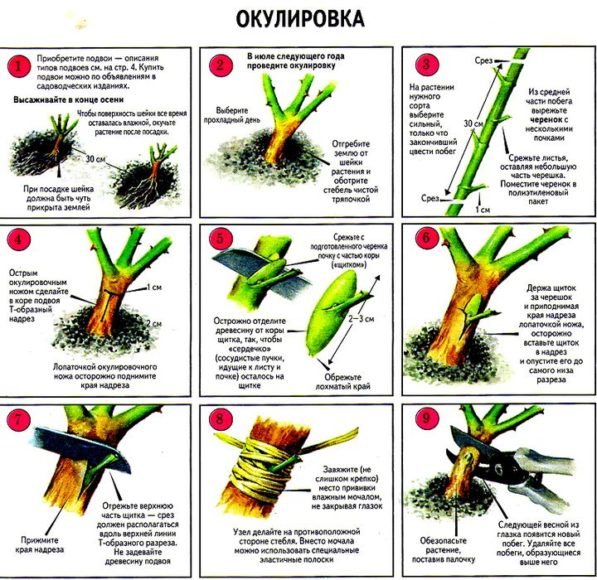

When choosing a method for propagating roses, it is necessary to take into account the type of roses, since budding is more suitable for some, and grafting for others. Groundcover, miniature, and also some varieties of small-flowered climbing roses reproduce well using cuttings. Large-flowered varieties of climbing roses and hybrid tea are best propagated by budding. Floribunda roses can be propagated by both grafting and cuttings, they are a hybrid of tea roses, but not so picky.
The biggest disadvantage of budding is that wild growth can begin to grow on the rootstock. This is solved quite simply, it is enough just to plant the root collar a little deeper and cut the rose hips, then the varietal qualities of the scion will take full effect in a few years.
Open ground readiness
The period of readiness of pink cuttings for planting in an open garden plot depends on the stage of its development and the degree of soil warming. And also the type of formation of the root system is taken into account:
- Open (on plants in newspapers, bags, water, etc.). The size of the roots is from 5 to 7 cm, the optimal time is from mid-April.
- Closed (for seedlings in pots, substrates, biodegradable containers, etc.). New leaves from 2 to 6 pieces, the optimal time is the first decade of May.
Important! In the presence of young green leaves, the time of planting in open ground is selected especially carefully: it is necessary to exclude any possibility of night frosts.
Spring is the most favorable time for planting.It is advisable to actively care for young cuttings for another 1-2 months, so that it is possible to correct developmental deviations. However, in the southern regions, planting can be done in autumn.
In order for the seedlings to grow well and bloom regularly in the future, you need to take care of their protection from cold and possible frost.
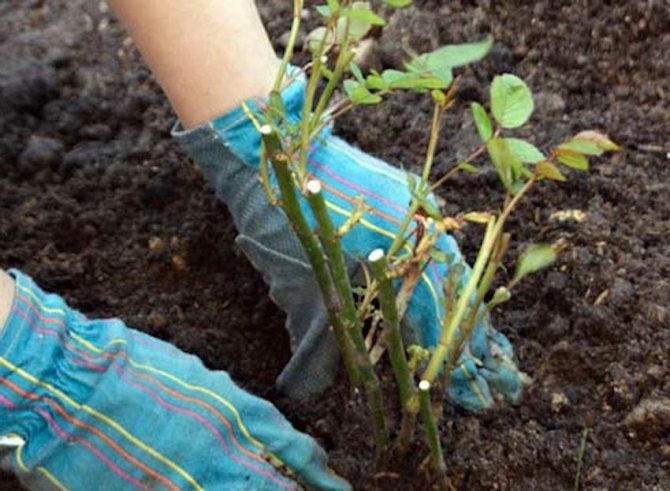

It is necessary to prepare the soil for planting in advance so that it has time to settle by the time of planting
The most widespread are 3 methods of insulation:
- Sprinkling and watering. Prevents cracking of the trunk, since it forms an ice "shell" on it, increasing the thermal conductivity and heat capacity of the earth. The sprinkling procedure must be repeated every half hour. It can be difficult to manually spray the leaves and stems repeatedly at night for several hours. Therefore, automatic watering is more suitable for this method. A positive effect is provided not only by the formed ice shell, but also by the heat released: when 1 gram of water freezes, 80 calories of energy are produced, which literally warms the seedlings.
- Smoke (fumigation). It has a direct heating effect and reduces the radiation of heat from the soil through an artificial smoke cloud. Instructions for smoke (fumigation) of the site:
- Collect a "three-layer cake" (height - 1 m, width - 1.5 m) from materials that are capable of smoldering with low burning: 1 layer - firewood and brushwood; 2nd layer - straw, manure and dry leaves; 3rd layer - earth (2-3 cm).
Place such blanks throughout the area in need of heating (1 pile per 10 m2).
- Make holes in the earth layer at the top and on the leeward side for better smoke release.
- Set fire to the onset of frost.
- Creation of shelters. Retains warmth by providing a physical barrier between plants and the environment. A variety of materials are suitable for creating shelters: polyethylene film and agrofibre;
- glass, including individual domes (jars);
- mulch (straw, crop residues, spruce branches, paper, cardboard, leaves, undecomposed compost);
- improvised devices (plastic bottles, boxes, containers, etc.).
Such heaps of smoke are designed for 15 hours of smoldering, which is quite enough to survive one frosty night.


Shelter of roses is held in late autumn
Important! If the weather permits, then in the daytime it is better to remove opaque shelters in order to give the plant access to sunlight.
When planting a rose in the autumn, it is important to choose the right time so that the seedling has time to take root in a new place, but does not begin to actively grow before the arrival of frost.
In this case, you will have to focus on the local climate. It should be borne in mind that rooting takes, as a rule, about 1–1.5 months.
Due to the large spread in time, it is recommended for novice gardeners to leave it to winter in indoor (basement) conditions, and start planting as early as next spring.
Features of growing a queen of flowers from a bouquet
Certain nuances of reproduction:
- For rooting, cuttings with insufficiently blossoming buds should be chosen.
- Cuttings with red, pink flowers are more reliable in propagation. White, yellow, orange roses have no chance to take root.
- When grown in winter, shoots need to provide additional lighting, optimal air humidity.
- Sometimes even an established stalk dies after a while.
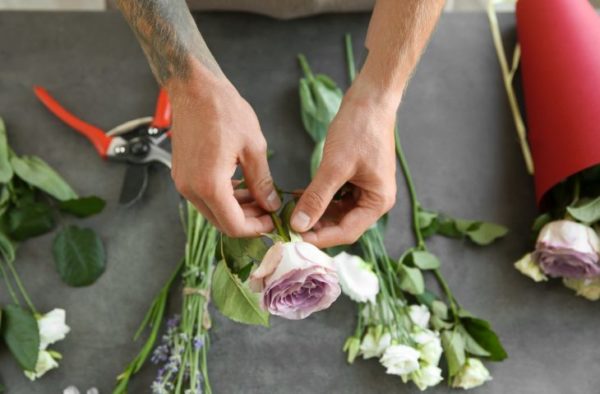

How to choose the right one?
To avoid any problems associated with breeding a rose, you must choose the right cuttings, taking into account the following recommendations:
- do not plant imported plants that were brought from abroad;
- it is undesirable to take very young or already stiff shoots;
- you need to take only strong bushes that do not get sick or wither.
For cultivation, domestic rose varieties are often used, which are already accustomed to the climatic conditions of the region where they are grown.
Experienced gardeners are advised to look at the condition of the stems. If the thorns begin to break, then the rose is already mature enough and ready for planting.
At home, you can grow indoor (for example, Bengal red, polyanthus) and Chinese roses from the cuttings. These types of flowers are not capricious, do not require any special care, they bloom for a long time and profusely.
You can also sprout a climbing (climbing) rose from a cutting (for example, the "dor" variety) and plant it in the open ground in your garden. Such flowers are used to decorate the walls of buildings, decorate arches or gazebos.
Many novice gardeners ask themselves the question: "How to grow roses from cuttings with wax?" If the stems are to be bred at home, then the wax should be removed. If you plan to plant seedlings in open ground, you do not need to remove the wax. It is worth noting that when buying wax-coated cuttings, you must carefully examine the planting material for signs of decay or disease.
How to root a rose correctly: basic recommendations
Not every flower can give roots and turn into a beautiful bush. Choose flowers based on the advice of gardeners and florists.
- Best of all, the roots of the classic rose scarlet
then
white
shades. The peculiarities of breeding make it almost impossible to germinate yellow, orange or blue varieties. - For rooting, choose russian roses
... Ecuadorian, Dutch and Kenyan are grown on a huge industrial scale, so they use special feeding. It is difficult to grow them in a normal environment. Russian production is more modest in comparison with foreign, and flowers grow in more natural conditions.
- Use fresh roses
... The longer the flower is in the vase, the less chance of success.
- Sprout easily summer flowers
, then spring and autumn, winter - in exceptional cases.
Growth activator application
For a more stable rooting of cuttings of roses, they are soaked for 10-24 hours in a weakly concentrated solution of any growth stimulant (regulator), which can be either professional or homemade.
Table: Means for enhancing root formation.
| Drug name | Active substance | Concentration per 1 liter of water, g / ml | The cost of 1 liter of ready-made solution, rub. |
| Heteroauxin, Kornerost | Indoleacetic acid | 0,2 | 30 |
| Kornevin | Indolylbutyric acid | 1 | 2 |
| Epin-Extra | Epibrassinolide | 0,2 | 5 |
| GO Bio Root Plus | Vitamins, enzymes, organic and humic acids | 5 | 16 |
| Zircon | Hydroxycinnamic acid | 1 | 20 |
| Etamon | Dimethylphosphoric acid dihydroxyethyl ammonium | 0,1 | 3 |
Preparing the solution at home:
- Willow infusion. Place a few twigs of willow in ordinary clean water and wait until they take root. After that, the nutrient fluid can be drained.
- Honey water. Dissolve 1 tsp. honey in 0.5 liters of warm boiled water.
- Yeast extract. Dilute raw baker's yeast in clean warm water at the rate of 100 g per 1 liter, while the effect can be enhanced by adding 1 tsp. Sahara.
- Aloe juice (gel). Grind the required amount of aloe leaves in a blender and strain the resulting gruel through several layers of gauze to separate the concentrated juice.
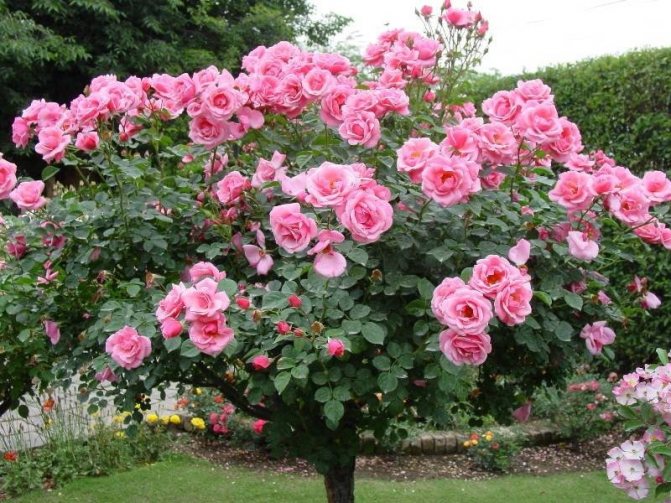

The use of growth activators promotes the formation of a more powerful root system of the rose
Advice. In a pure gel of aloe leaves, the cutting can be left for 10-12 hours, after which it is advisable to dilute the juice with water (1: 9) and leave in this form for another 10-12 hours or for the entire period of development of the root system (with the water method of cuttings ).
The choice of a growth promoter depends on the capabilities and desires of the grower, but it is worth noting that the action of chemicals is more targeted than that of its natural counterparts.Already on the 12-15th day of using these drugs, the cuttings have their own root system (versus the standard 30 days). It should also be remembered that when working with chemicals, it is very important to observe the permissible concentration indicated on the packaging and the precautions.
Reproduction of standard roses
To grow standard roses, it takes twice as long as for bush roses. It takes 3 years only to grow a stock stock with a height of 1.5 m. For the successful cultivation of a standard stock, careful selection of special vigorous rosehip forms is required. As a rule, a strong one-year shoot is used, which has grown from a dormant bud at the base of the bush in the 2nd - 3rd year of the growing season. The emergence and intensive growth of such shoots is facilitated by the spring cutting of all last year's renewal shoots. In this case, by the fall of the third year, shoots up to 1.5 m and more grow on most bushes, suitable for a standard stock, with a diameter of more than 10 mm. On each bush, one of the highest and straightest shoot is chosen, the rest are cut out at the very root collar.
Budding at the usual time is carried out at a height of 75; 100 or 150 cm. Two buds are grafted from different sides of the stem at a distance of 3 - 4 cm. Low stems 75 cm high are usually occulted with miniature roses, and the highest 150 cm, the so-called cascading, or weeping ones - with climbing and ground cover.
The varieties with bright flowers of different colors, obtained as a result of repeated grafting, are especially effective on a tall trunk.
For the winter, the grafted boles are bent down, covered with earth and covered. In the spring, the stem is raised and, as soon as the buds begin to swell, it is cut off over the grafted eye. During spring and summer, the grown shoots are pinched to form a crown, and wild growth is removed. To maintain the stem in an upright position, pegs or a trellis made of wire are used.
Preparing cuttings
Young and herbaceous flower shoots are completely unsuitable for cuttings at home. But the stems of one year of life, with a girth of approximately four to six millimeters, which either have not yet begun to bloom or are already fading, are perfect for these purposes. It's all about the significant content of the amount of carbohydrates in such cuttings, which contribute to faster and more efficient rooting.
How to grow roses from cuttings of donated roses or grown on your own flower garden? Let's talk about this further.
Cuttings of roses should be cut to a length not exceeding 25 cm. When cutting the stems into cuttings, it is very important to make sure that there are at least three buds on them. Cutting cuttings should be done with a sharpened tool (for example, a special pruner), treated with alcohol and boiling water. The lower cut is made obliquely - at an angle of about 45 degrees under the kidney. The upper cut is made straight, slightly higher than the kidney. In addition, at the bottom cut, it is better to make another light cut along the stem, about two centimeters long. This will speed up root formation.
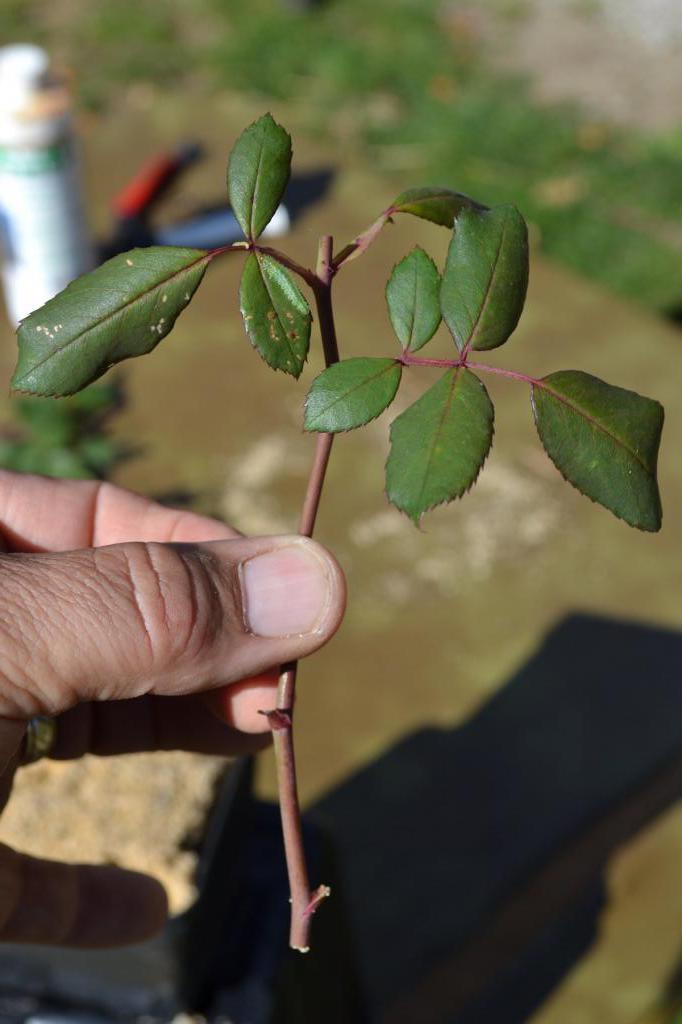

We must not forget that until the roots have formed in the cutting, its moisture reserve will not be replenished. Therefore, it is very important to reduce the volatility of the existing one. For this purpose, the leaves are partially removed: the upper ones are cut off by about a third, and the lower ones are removed completely.
To increase the percentage of successfully rooted cuttings, experienced gardeners resort to keeping the bottom cut in various liquid biostimulants for plants for half a day (for example, in "Heteroauxin" or "Epin"). Or they simply dip the cut into a dry powdery biostimulant (for example, in "Kornevin"). You can do without them, but this increases the risk of not having a good result, since the use of stimulants in certain quantities has a beneficial effect on the survival rate of cuttings.At the same time, it is very important not to allow the concentration of these substances to be exceeded, otherwise it can negatively affect the flowers. Therefore, it is necessary to strictly follow the instructions indicated on the packaging of such drugs. Consider ways to grow a rose from a cut of a purchased rose or one grown on your site.
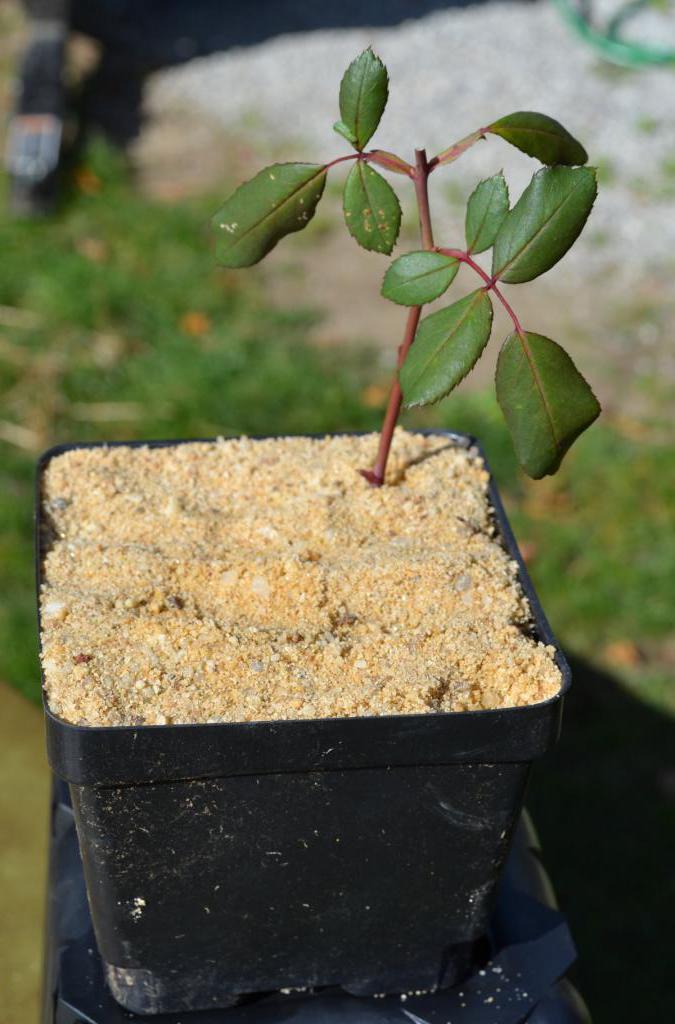

How to cut the stem of a home rose from the ground?
For propagation of garden roses, specimens with not yet formed buds are chosen. The selected stem is divided into several parts. The optimal length of the cutting is 7-8 cm. On each segment, there must be from 2 to 3 buds and several leaves.
REFERENCE: If the selected stem is short, then one stalk is formed from it.
Separating the first segment, a perpendicular cut should be made on the stem. The second stalk is separated with a sharp knife, cutting it off at an angle of 45%. The last cut is made directly under the kidney - this place contains the maximum amount of nutrients.
Correct separation of the cuttings ensures faster root formation.
Optimal conditions for the emergence of roots
The roots of pink seedlings appear after about a month. With any method of grafting, it is important to withstand a temperature of about 20 degrees and increased atmospheric humidity up to this point. You should not keep future roses in bright sunlight to avoid burns. If they are in a greenhouse or greenhouse, ventilation is required in the morning and evening.
The use of growth stimulants
Soaking with a special biostimulator accelerates the appearance of roots. If it is purchased, you need to keep the stems for six hours.
Purchased root stimulation products:
| Biostimulating drug | Correct proportions of solution (agent / water) |
| "Kornevin" | 1 gram per liter |
| "Radifarm" | 2 drops per liter |
| "Heteroauxin" | 1 tablet for 2.5 liters |
| "Epin extra" | 1 ampoule for 2 liters |
| "Zircon" | 1 milliliter per 10 liters |
When using Radifarm, the soaking time is reduced to half an hour - the drug is very active. You can use folk methods - an aqueous solution of aloe juice (9: 1) or water with honey (a small spoon is dissolved in 500 ml of water). Then the soaking process is extended up to 24 hours.
Cold season care
In winter, it is important not to overheat the rose. Ideally, the pot should be located in a room where the temperature is constantly maintained at + 15⁰С. But during the heating season, it is almost impossible to do this. Therefore, it is necessary to ventilate the house more often, only so that the cold air does not immediately fall on the plant.
In autumn, a home rose is cut, leaving no more than 4-5 buds on each shoot. Cut branches can be used as planting material. Watering is reduced to once every 5-7 days.
The bushes will be fertilized with the beginning of active growth, once every two weeks. Use a solution of poultry manure or inorganic universal fertilizers.
In general, the grooming pattern is the same as when growing other indoor plants.
Autumn cuttings
As mentioned above, in order for the cuttings to root normally, they need approximately room temperature and good illumination. That is why cuttings on open ground are carried out in late spring and summer, and in winter only in heated rooms. But if the cuttings were at your disposal on the eve of winter, and you have nowhere to root them in pots, or you simply don’t want to, they can be “preserved” until spring.
Autumn cuttings just allow you to keep the shoots alive and healthy until spring, without allowing them to take root (which would lead to the death of a plant that did not have time to get stronger). With the arrival of spring, cuttings "preserved" in the ground will be fully ready for planting and rooting under normal conditions.
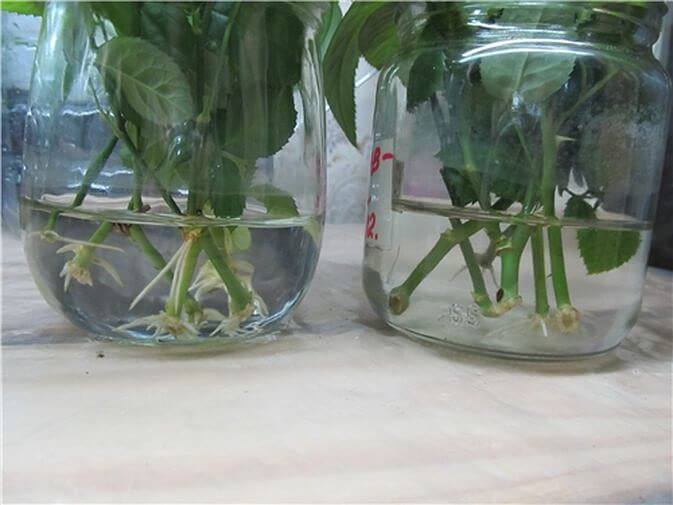

This method is very popular, because in the fall, growers prune rose bushes, as a result of which there are many cuttings that are simply a pity to throw in the trash.
To save the cuttings until spring, they need to be dug into the ground completely, leaving nothing above the ground. In this case, the garden bed should not be placed where it is convenient for you, but where the most snow is swept in winter. Usually such a place is the north side of the fence or one of the blank walls of the house / shed. It is advisable to sprinkle dry peat on top with a small layer and, if possible, cover the garden bed with dry leaves or spruce branches. We have already described how to grow a climbing rose from a cuttings that have wintered in such conditions.

